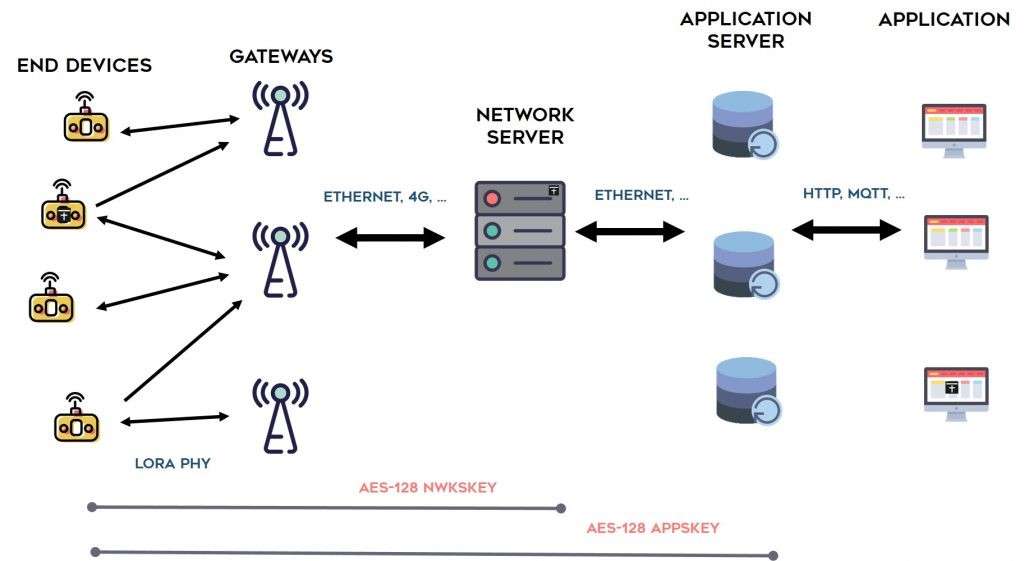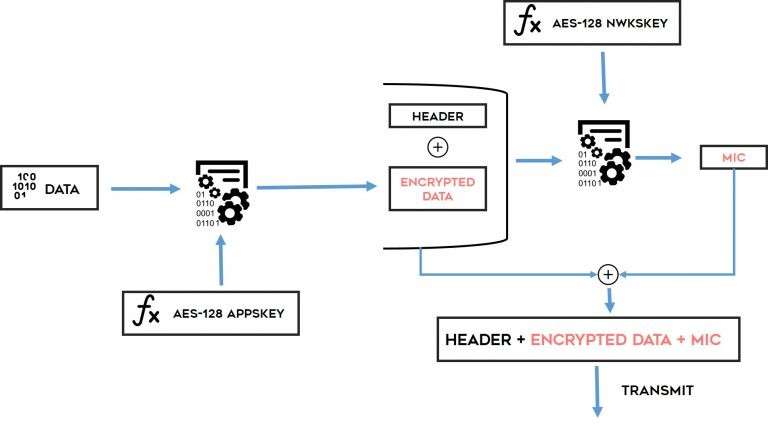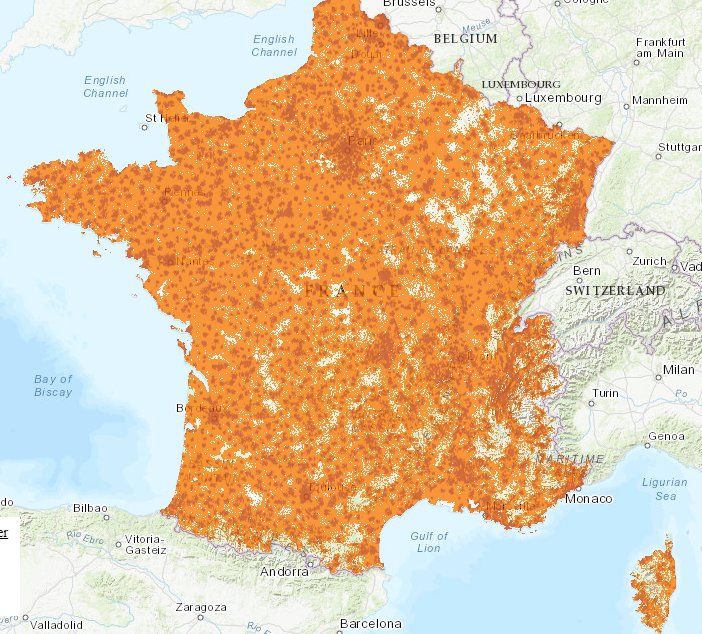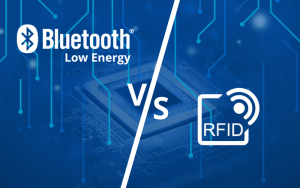
Created in 2009 by a French company, the LoRacommunication technology belongs since 2012 to the American company Semtech. The international development of this technology makes it possible to cover, to this day, more than 140 countries around the world. In order to standardize this means of communication for connected devices, the LoRa Alliance has developed a protocol called LoRaWAN. This communication protocol allows any company to deploy its LoRaWAN tags and thus, to transmit small packets of data such as positions, temperatures or identifiers over several kilometers on private or operated / public networks. In France, Orange and Bouygues (Objenious) have deployed their own IoT network throughout the country, but by 2019 there will be more than 120 operators worldwide.
In order to help you to better understand this communication technology and to choose the network that best suits your needs, we propose you to approach the technical operation of LoRaWAN, to make a comparison between public network and private network and to finally discover some typical applications.
LoRaWAN’s operating principle
LoRaWAN (Long Range Radio Wide Area Network), is a low speed, long range network protocol based on LoRa radio (modulation) technology. This standard and open protocol, promoted by the LoRa Alliance since 2015, operates in the ISM frequency bands (around 868 MHz for Europe) and uses spread spectrum modulation – a variant of chirp spread spectrum modulation to be more precise.
LoRaWAN a star network
A LoRaWAN network is composed of devices(connected objects) communicating in LoRa with gatewayswhich, in turn, upload data to the servers via a 3G, Ethernet, WIFI or other connection. In turn, the server sorts the information and sends only the relevant data back to the GUI. This is known as a star network.
In this type of operation, all the intelligence of the network is provided by the server that goes :
- Manage information flow
- Secure the data
- Manage redundancy of received data

A secure network
With the rise of connected devices, cybersecurityissues have emerged. With more than 22 billion Internet-connected devices worldwide, the IoT market is a perfect target. To overcome these cybersecurity issues, LoRaWAN ensures network and data security thanks to two AES-128 encryptions.
- The first, via the Network Session Key (NwkSKey), ensures the authenticity of the equipment.
- The second, via the Application Session Key (AppSKey), ensures the security and confidentiality of data transmitted over the network.
In order to ensure optimal network security and to prevent a third party from viewing the data, the application key is known only to the application provider. The network key is communicated by the network operator to authorized application providers.

Activating LoRa equipment
In order to be able to communicate via the LoRaWAN network, the equipment must imperatively obtain these two security keys. For this, two methods are possible: the OTAAmethod and the APBmethod.
- The OTAA method: the device must transmit a request of type LoRa: join request in which 3 elements must appear: the DevEUI, the AppEUI and the AppSKey.
- The APB method: For this method, the session keys NwkSKey and AppSKey as well as the equipment address (DevAddr) are directly written in the LoRaWAN equipment.
NB: the OTAA method is more complex to implement than the APB method but offers a higher level of security. For large-scale deployment, it is advisable to use the OTAA method, which is more secure and agile.
LoRaWAN private network Vs public network
Following the example of communication technologies such as 3G or WIFI, the LoRaWAN network can be publicby relying on antennas deployed by telecom operators, but it can also be private. Indeed, a company can create its own LoRaWAN network if it wishes to do so. However, it is important to keep in mind that regardless of the nature of the network, it is necessary to respect the channel occupancy times (duty cycle) even though the occupation of the frequency bands is free. But what are the pros and cons of these two possibilities?
LoRaWAN private network
In France, Orange covers almost the entire territory with the public LoRaWAN network (known as “operated”). Thanks to this network infrastructure, connected devices can exchange data over very long distances of up to several kilometers. In an urban landscape where there are many obstacles, connected equipment can send a message to a terminal located about 1 kilometer away, but in rural areas this distance can be up to 20 km.
Benefits
- National coverage set up by telecom operators
- IoT platform provided by operators
- Operator-managed network infrastructure
- Possibility to expand internationally with Roaming
Cons
- Subscription-based business model that can be costly if the number of devices becomes large
- Dependence on the operator’s network coverage
Orange LoRaWAN coverage area

LoRaWAN private network
Although public network coverage in France is good, many companies prefer to opt for private networks. Companies with no real need for mobility in the management of their fleet of sensors may be attracted by the installation of a private network. The main advantages beinginformation security, since in a private network, the company can connect its system to the network without having to use the Internet, as well as the cost of acquisition, since the company does not have to pay a subscription to an operator. In this context, the company must install the entire network infrastructure (devices, gateways, servers, business application), but this can generate economies of scale when the number of connected devices becomes large.
Benefits
- The company owns its network infrastructure
- Secure network protecting the data circulating on it
- No subscription
- Ability to interface with the company’s business application
Cons
- Significant infrastructure costs at launch
- Recurrent maintenance costs
- Requires in-house skills in radio engineering and deployment
LoRaWAN dedicated network
To alleviate the problems mentioned above, it is possible to opt for a so-called “dedicated” network. This hybrid network combines the benefits of private and public LoRaWAN networks. By choosing this system, companies can use their own tailor-made infrastructure on an unlimited basis, as well as a connection to the national network. This solution guarantees users an optimal quality of service while maintaining their autonomy.
LoRaWAN network, for which business applications?
Due to its very long transmission range, the LoRa communication technology is suitable for many applications. Indeed, whether in the field of smart building or geolocation, LoRa sensors and tags are resolutely made for industrial business applications. However, it should be kept in mind, that for reasons of intelligent battery management, the LoRaWAN connected objects emit periodically. 1 time per hour, per day or per week depending on the application addressed.
In smart buildings, temperature, humidity, light and motion sensors can be used to improve the energy management of buildings. This can be, for example, the remote monitoring of the temperature in the boiler rooms of different buildings several kilometers away from each other.
As far as geolocationis concerned, the tags connected in LoRaWAN make it possible to locate equipment several hundred kilometers away. This can be useful to geolocate dumpsters or trucks on a logistic site of several square kilometers.
Things to remember
LoRa communication technology and its LoRaWAN protocol are developing more and more on a global scale and this will revolutionize certain industrial sectors such as logistics, with the possibility of tracing the movements of trucks and equipment internationally. There is still a choice to make between private network, operated network or dedicated network. For this it is necessary to evaluate the needs and infrastructure costs involved, but also the possibility ofmanaging the installation and maintenance in-house or not. To learn more about this communication protocol, we invite you to visit the LoRa Alliance website.





